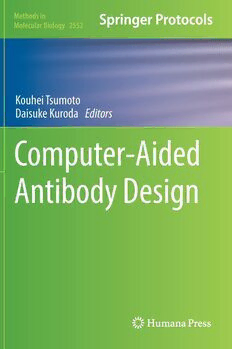
Computer-Aided Antibody Design PDF
Preview Computer-Aided Antibody Design
Methods in Molecular Biology 2552 Kouhei Tsumoto Daisuke Kuroda Editors Computer-Aided Antibody Design M M B ETHODS IN OLECULAR IO LO GY SeriesEditor JohnM.Walker School of Lifeand MedicalSciences University ofHertfordshire Hatfield, Hertfordshire, UK Forfurther volumes: http://www.springer.com/series/7651 For over 35 years, biological scientists have come to rely on the research protocols and methodologiesinthecriticallyacclaimedMethodsinMolecularBiologyseries.Theserieswas thefirsttointroducethestep-by-stepprotocolsapproachthathasbecomethestandardinall biomedical protocol publishing. Each protocol is provided in readily-reproducible step-by step fashion, opening with an introductory overview, a list of the materials and reagents neededtocompletetheexperiment,andfollowedbyadetailedprocedurethatissupported with a helpful notes section offering tips and tricks of the trade as well as troubleshooting advice. These hallmark features were introduced by series editor Dr. John Walker and constitutethekeyingredientineachandeveryvolumeoftheMethodsinMolecularBiology series. Tested and trusted, comprehensive and reliable, all protocols from the series are indexedinPubMed. Computer-Aided Antibody Design Edited by Kouhei Tsumoto and Daisuke Kuroda School of Engineering, The University of Tokyo, Tokyo, Japan Editors KouheiTsumoto DaisukeKuroda SchoolofEngineering SchoolofEngineering TheUniversityofTokyo TheUniversityofTokyo Tokyo,Japan Tokyo,Japan ISSN1064-3745 ISSN1940-6029 (electronic) MethodsinMolecularBiology ISBN978-1-0716-2608-5 ISBN978-1-0716-2609-2 (eBook) https://doi.org/10.1007/978-1-0716-2609-2 ©SpringerScience+BusinessMedia,LLC,partofSpringerNature2023 Chapter 2 is licensed under the terms of the Creative Commons Attribution 4.0 International License (http://creativecommons.org/licenses/by/4.0/).Forfurtherdetailsseelicenseinformationinthechapter. Thisworkissubjecttocopyright.AllrightsarereservedbythePublisher,whetherthewholeorpartofthematerialis concerned,specificallytherightsof translation,reprinting,reuseofillustrations,recitation,broadcasting,reproduction onmicrofilmsorinanyotherphysicalway,andtransmissionorinformationstorageandretrieval,electronicadaptation, computersoftware,orbysimilarordissimilarmethodologynowknownorhereafterdeveloped. Theuseofgeneraldescriptivenames,registerednames,trademarks,servicemarks,etc.inthispublicationdoesnotimply, evenintheabsenceofaspecificstatement,thatsuchnamesareexemptfromtherelevantprotectivelawsandregulations andthereforefreeforgeneraluse. Thepublisher,theauthors,andtheeditorsaresafetoassumethattheadviceandinformationinthisbookarebelievedto betrueandaccurateatthedateofpublication.Neitherthepublishernortheauthorsortheeditorsgiveawarranty, expressedorimplied,withrespecttothematerialcontainedhereinorforanyerrorsoromissionsthatmayhavebeen made.Thepublisherremainsneutralwithregardtojurisdictionalclaimsinpublishedmapsandinstitutionalaffiliations. ThisHumanaimprintispublishedbytheregisteredcompanySpringerScience+BusinessMedia,LLC,partofSpringer Nature. Theregisteredcompanyaddressis:1NewYorkPlaza,NewYork,NY10004,U.S.A. Preface Antibodies play important roles in immune system. They recognize variety of foreign molecules or antigens, which in turn induce further immune responses to protect our body from external perturbation. The number of antigens is far more than the number of antibodygenes,butseveralmechanisms,suchasV(D)Jrecombination,V /V pairingand L H somatic maturation, exist to expand the diversity of antibodies. Due to these features, antibodies are versatile molecules that exhibit high affinity and specificity toward target moleculesandcanbeusedastherapeuticaswellasdiagnosticreagents. Drugdiscoveryanddevelopmentarecomplexprocesses,whereincomputationalmeth- odsplaycrucialrolesmainlyintwoparts:leadgenerationandleadoptimization.Although steadily improving, computational lead generation or de novo design of molecules is still challenging.Ontheotherhand,computationalmethodsarealmostuniversallyacceptedas importanttoolsfortheoptimizationofdrugcandidates,helpingwithtaskssuchasoptimiz- ing affinity for a target, minimizing off-target effects, and optimizing pharmacokinetic properties. In this context, the computational methods are generally not considered sub- stitutes for empirical testing, but rather a way to generate testable hypotheses, helping to interpretandguideexperiments. Computer-aided molecular design has a long history, and various computational tech- nologieshavebeenusedinthedevelopmentofsmall-moleculedrugsfordecades.Sincethe computational cost for molecular design of small molecules is relatively low, even in an era when large supercomputers cannot be used, it could be treated as a calculation target. Likewise,computationalmodelinghascontributedtothedesignoftherapeuticantibodies, notablyinearlyattemptsathumanizingantibodies.Sincethen,withtheadventofcompu- tational speed and accuracy, computational methods have garnered much attention in antibody research and drug discovery. Several computational algorithms have been pro- posedinliterature. The aims of this book are to review the current status of computer-aided antibody design and to provide audience with standard protocols of state-of-the-art methods. The chapters are organized into five interrelated parts: (1) Information of Antibody Sequences and Structures, (2) Modeling Antibody Structures and Dynamics, (3) Prediction and Optimization of Biological and Biophysical Properties of Antibodies, (4) Prediction of Antibody-Antigen Interactions, and (5) Computer-Aided Antibody Affinity Maturation andBeyond. Wehopethatthisbookwillbeusefulnotonlyforcomputationalbiologistsbutalsofor proteinengineersandmedicinalchemistsfrombothacademiaandindustry. SchoolofEngineering KouheiTsumoto TheUniversityofTokyo,Tokyo,Japan DaisukeKuroda v Contents Preface ..................................................................... v Contributors................................................................. xi PART I INFORMATION OF ANTIBODY SEQUENCES AND STRUCTURES ® 1 AntibodySequenceandStructureAnalysesUsingIMGT : 30YearsofImmunoinformatics........................................... 3 Marie-PauleLefrancandGe´rardLefranc 2 StructuralClassificationofCDR-H3inSingle-DomainV HAntibodies ...... 61 H DaisukeKurodaandKouheiTsumoto PART II MODELING ANTIBODY STRUCTURES AND DYNAMICS 3 ComputationalModelingofAntibodyandT-Cell Receptor(CDR3Loops).... ........ ....... ....... ........ ....... ........ 83 FrederikkeI.MarinandPaoloMarcatili 4 MolecularDynamicsSimulationforInvestigating Antigen–AntibodyInteraction....... .. ..... ...... ...... ... ....... ........ 101 TakefumiYamashita 5 MolecularDynamicsMethodsforAntibodyDesign.......... ....... ........ 109 MatthewCarterChildersandValerieDaggett 6 ProbingConformationalDynamicsofAntibodies withGeometricSimulations......... ....... ....... ........ ....... ........ 125 AndrejsTucs,KojiTsuda,andAdnanSljoka PART III PREDICTION AND OPTIMIZATION OF BIOLOGICAL AND BIOPHYSICAL PROPERTIES OF ANTIBODIES 7 PITHA:AWebtooltoPredictImmunogenicityforHumanized andFullyHumanTherapeuticAntibodies.... ...... ....... .. ....... ........ 143 ShideLiangandChiZhang 8 ThermalStabilityEstimationofSingleDomainAntibodies UsingMolecularDynamicsSimulations...... ....... ........ ....... ........ 151 Gert-JanBekkerandNarutoshiKamiya 9 AssessingandEngineeringAntibodyStabilityUsingExperimental andComputationalMethods........ ....... ....... ........ ....... ........ 165 ChengZhangandPaulAnthonyDalby 10 InSilicoPredictionMethodforProteinAsparagineDeamidation..... ....... . 199 LeiJiaandYaxiongSun vii viii Contents 11 Structure-BasedOptimizationofAntibody-BasedBiotherapeutics forImprovedDevelopability:APracticalGuide forMolecularModelers..... ........ ....... ....... ........ ....... ........ 219 NelsThorsteinson,StephenR.ComeauJr,andSandeepKumar PART IV PREDICTION OF ANTIBODY-ANTIGEN INTERACTIONS 12 B-CellEpitopePredictionsUsingComputationalMethods.......... ........ 239 DandanZheng,ShideLiang,andChiZhang 13 ComputationalEpitopePredictionandDesignforAntibody DevelopmentandDetection ........ ....... ....... ........ ....... ........ 255 RiccardoCapelli,StefanoA.Serapian,andGiorgioColombo 14 Information-DrivenAntibody–AntigenModellingwithHADDOCK ....... .. 267 FrancescoAmbrosetti,ZuzanaJandova, andAlexandreM.J.J.Bonvin 15 StructuralModelingofAdaptiveImmuneResponsestoInfection..... ........ 283 TinaLusiany,ZichangXu,DianitaS.Saputri,HendraS.Ismanto, SedatAybarsNazlica,andDaronM.Standley 16 Protein–ProteinInteractionModellingwiththeFragmentMolecular OrbitalMethod..... ....... ........ ....... ....... ........ ....... ........ 295 ShigenoriTanaka PART V COMPUTER-AIDED ANTIBODYAFFINITY MATURATION AND BEYOND 17 StructuralConsiderationsinAffinityMaturationofAntibody-Based BiotherapeuticCandidates .......... ....... ....... ........ .... ... ...... .. 309 StephenR.Comeau,NelsThorsteinson,andSandeepKumar 18 Structure-BasedAffinityMaturationofAntibodyBased onDouble-PointMutations......... ....... ....... ........ ....... ........ 323 ShuntaroChiba,YasushiOkuno,andMasateruOhta 19 AntibodyAffinityMaturationUsingComputationalMethods:From anInitialHittoSmall-ScaleExpressionofOptimizedBinders........ ........ 333 BarbaraMedagli,MiguelA.Soler,RitaDeZorzi, andSaraFortuna 20 OptimizingAntibody–AntigenBindingAffinities withtheADAPTPlatform .......... ....... ....... ........ ....... .... .... 361 TraianSulea,ChristopheDeprez,ChristopherR.Corbeil, andEnricoO.Purisima 21 UsingGraph-BasedSignaturestoGuideRationalAntibodyEngineering ...... 375 DavidB.Ascher,LisaM.Kaminskas,YoochanMyung, andDouglasE.V.Pires 22 AComputationalFrameworkforDeterminingtheBreadth ofAntibodiesAgainstHighlyMutablePathogens.... ........ ....... ........ 399 SimoneContiandMartinKarplus Contents ix 23 AnalyticalMethodforExperimentalValidation ofComputer-DesignedAntibody.... ....... ....... ........ ....... ........ 409 AkiTanabeandKouheiTsumoto PART VI SYNTHETIC ANTIBODY LIBRARY, NEXT GENERATION SEQUENCING OF B-ELL REPERTOIRES AND IMMUNOTHERAPY 24 ComputationalAnalysisofAntibodyParatopesforAntibody SequencesinAntibodyLibraries..... ....... ....... ........ ....... ........ 437 Hung-PinPengandAn-SueiYang 25 BioinformaticAnalysisofNativelyPairedVH:VLAntibodyRepertoires forAntibodyDiscovery..... ........ ....... ....... ....... ....... ......... 447 AhmedS.Fahad,BharatMadan,andBrandonJ.DeKosky 26 AnalyzingAntibodyRepertoireUsingNext-GenerationSequencing andMachineLearning...... ........ ....... ....... ........ ....... ........ 465 ShutoHayashiandShumpeiIshikawa 27 AComputationalPipelineforPredictingCancerNeoepitopes........ ........ 475 Anna-LisaSchaap-JohansenandPaoloMarcatili Index ...................................................................... 489 Contributors FRANCESCOAMBROSETTI • ComputationalStructuralBiologyGroup,BijvoetCentrefor BiomolecularResearch,FacultyofScience–Chemistry,UtrechtUniversity,Utrecht,The Netherlands DAVIDB.ASCHER • StructuralBiologyandBioinformatics,DepartmentofBiochemistryand MolecularBiology,Bio21Institute,UniversityofMelbourne,Parkville,VIC,Australia; ComputationalBiologyandClinicalInformatics,BakerHeartandDiabetesInstitute, Melbourne,VIC,Australia;DepartmentofBiochemistry,CambridgeUniversity, Cambridge,UK;SchoolofChemistryandMolecularBiosciences,UniversityofQueensland, StLucia,Queensland,Australia GERT-JANBEKKER • InstituteforProteinResearch,OsakaUniversity,Osaka,Japan ALEXANDREM.J.J.BONVIN • ComputationalStructuralBiologyGroup,BijvoetCentrefor BiomolecularResearch,FacultyofScience–Chemistry,UtrechtUniversity,Utrecht,The Netherlands RICCARDOCAPELLI • SCITEC-CNR,Milan,Italy;PolitecnicodiTorino,Departmentof AppliedScienceandTechnology,Torino,Italy SHUNTAROCHIBA • RIKENCenter forComputationalScience,RIKEN,Yokohama,Japan MATTHEWCARTERCHILDERS • DepartmentofBioengineering,UniversityofWashington, Seattle,WA,USA GIORGIO COLOMBO • SCITEC-CNR,Milan,Italy;Universit`adiPavia,Dipartimentodi Chimica,Pavia,Italy STEPHENR.COMEAUJR • ComputationalBiochemistryandBioinformaticsGroup, BiotherapeuticsDiscovery,BoehringerIngelheimPharmaceuticalInc.,Ridgefield,CT, USA SIMONECONTI • DepartmentofChemistryandChemicalBiology,HarvardUniversity, Cambridge,MA,USA CHRISTOPHERR.CORBEIL • NationalResearchCouncilCanada,HumanHealth TherapeuticsResearchCentre,Montreal,QC,Canada VALERIE DAGGETT • DepartmentofBioengineering,UniversityofWashington,Seattle,WA, USA PAULANTHONYDALBY • DepartmentofBiochemicalEngineering,UniversityCollege London,London,UK RITADEZORZI • DepartmentofChemicalandPharmaceuticalSciences,Universityof Trieste,Trieste,Italy BRANDONJ.DEKOSKY • DepartmentofPharmaceuticalChemistry,TheUniversityof Kansas,Lawrence,KS,USA;DepartmentofChemicalEngineering,TheUniversityof Kansas,Lawrence,KS,USA;BioengineeringGraduateProgram,TheUniversityof Kansas,Lawrence,KS,USA CHRISTOPHEDEPREZ • NationalResearchCouncilCanada,HumanHealthTherapeutics ResearchCentre,Montreal,QC,Canada AHMEDS.FAHAD • DepartmentofPharmaceuticalChemistry,TheUniversityofKansas, Lawrence,KS,USA SARAFORTUNA • DepartmentofChemicalandPharmaceuticalSciences,Universityof Trieste,Trieste,Italy;CONCEPTLab,IstitutoItalianodiTecnologia,Genova,Italy xi
